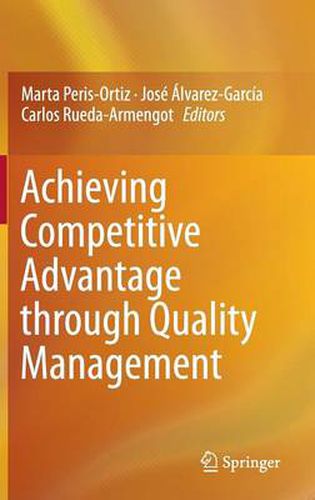Readings Newsletter
Become a Readings Member to make your shopping experience even easier.
Sign in or sign up for free!
You’re not far away from qualifying for FREE standard shipping within Australia
You’ve qualified for FREE standard shipping within Australia
The cart is loading…






This title is printed to order. This book may have been self-published. If so, we cannot guarantee the quality of the content. In the main most books will have gone through the editing process however some may not. We therefore suggest that you be aware of this before ordering this book. If in doubt check either the author or publisher’s details as we are unable to accept any returns unless they are faulty. Please contact us if you have any questions.
This book examines the ways in which quality management methods, tools, and practices help improve an organization’s performance and achieve sustainable competitive advantages. This volume includes quality techniques and tools such as the EFQM Model, SERVPERF model, E-S-Qual scale and the ISO 9001 certification and provide a wide variety of empirical studies in different economic sectors.
In the current economic environment, characterized by economic turmoil and fierce competition, quality management has become a key strategy for organizations to overcome today’s challenges. Organizations benefits from implementing quality management systems by following two approaches. First, they implement quality practices aimed at ensuring customer satisfaction by considering consumer expectations and establishing strategies accordingly. Second, organizations improve processes by establishing efficient and effective process management systems that improve productivity, lower costs, reduce unnecessary expenses, eliminate all non-value added activities, and ultimately maximize excellence and customer satisfaction. Quality management thereby provides tools, techniques, and methods for continuous process improvement in both the professional and academic worlds, which, when implemented by organizations in times of crisis, enable more effective administration of activities undertaken by managers.
Containing contributions from various academics and scholars, this new book provides cutting edge research, methods and techniques providing a reference manual for academics, scholars, practitioners and policy-makers.
$9.00 standard shipping within Australia
FREE standard shipping within Australia for orders over $100.00
Express & International shipping calculated at checkout
This title is printed to order. This book may have been self-published. If so, we cannot guarantee the quality of the content. In the main most books will have gone through the editing process however some may not. We therefore suggest that you be aware of this before ordering this book. If in doubt check either the author or publisher’s details as we are unable to accept any returns unless they are faulty. Please contact us if you have any questions.
This book examines the ways in which quality management methods, tools, and practices help improve an organization’s performance and achieve sustainable competitive advantages. This volume includes quality techniques and tools such as the EFQM Model, SERVPERF model, E-S-Qual scale and the ISO 9001 certification and provide a wide variety of empirical studies in different economic sectors.
In the current economic environment, characterized by economic turmoil and fierce competition, quality management has become a key strategy for organizations to overcome today’s challenges. Organizations benefits from implementing quality management systems by following two approaches. First, they implement quality practices aimed at ensuring customer satisfaction by considering consumer expectations and establishing strategies accordingly. Second, organizations improve processes by establishing efficient and effective process management systems that improve productivity, lower costs, reduce unnecessary expenses, eliminate all non-value added activities, and ultimately maximize excellence and customer satisfaction. Quality management thereby provides tools, techniques, and methods for continuous process improvement in both the professional and academic worlds, which, when implemented by organizations in times of crisis, enable more effective administration of activities undertaken by managers.
Containing contributions from various academics and scholars, this new book provides cutting edge research, methods and techniques providing a reference manual for academics, scholars, practitioners and policy-makers.